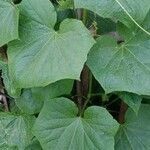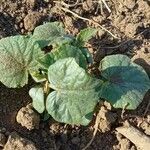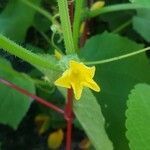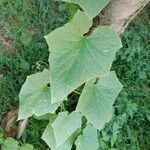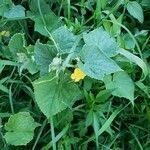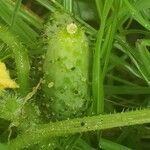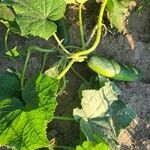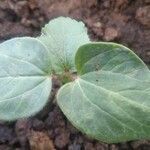Vines; stems hirsute or scabrous. Leaves cordate, 12-18 cm long and wide, angulate or shallowly 3-to 5-lobate, the apex of the lobes acute, the base cordate, the margin denticulate, chartaceous, both surfaces hispid or scabrous; petiole 5-15 cm long, hispid or scabrous. Staminate flowers axillary, fasciculate; peduncle 0.5-2.0 cm long; calyx subcylindrical, the lobes 4-6 mm long, subulate, villous, green; corolla campanulate, lobes ca. 2 cm long, yellow, ovate lanceolate, acute; stamens 6-8 mm long, the anthers 3-4 mm long, the appendix connective ca. 1 mm long; pistillode glandlike. Pistillate flowers in same axils as the staminate flowers; peduncles 1-2 cm long; calyx and corolla as in the staminate flowers; ovary fusiform, tuberculate, the style 1-2 mm long, the stigma forming a spherical head. Fruit yellowish, usually cylindrical or oblong, tuberculate, glabrous; seeds whitish, oblong, 8-10 mm long, 3-5 mm wide.
Plants scandent or creeping. Stem and branches angular, white hispid. Tendrils slender, simple. Petiole 10-16(-20) cm; leaf blade broadly ovate-cordate, 7-20 × 7-20 cm, membranous, margin 3-5-angular or-lobed; lobes triangular, dentate, apex acute or acuminate; sinus half-orbicular. Plants monoecious. Male flowers fasciculate; pedicel filiform, 5-15 mm, puberulent; calyx tube narrowly campanulate, 8-10 mm, densely white pubescent; segments subulate; corolla yellow-white, ca. 2 cm; segments oblong-lanceolate, acute; anthers 3-4 mm; connective ca. 1 mm. Female flowers solitary or fascicled; pedicels pubescent, 1-2 cm; ovary fusiform, muricate. Fruit yellow-green, oblong or cylindric, (5-)10-30(-50) cm, muricate, usually verrucose. Seeds white, small, narrowly ovate, 5-10 mm, emarginate, both ends acute. Fl. and fr. summer.
A pumpkin family plant. It is a hairy annual climber with tendrils and yellow flowers. It grows to 0.5 m high and spreads to 2 m wide. The stem is trailing and has bristles. The leaves are heart shaped and the lobes taper. Leaf shape varies with different varieties. The tendrils are not branched. The flowers are yellow and funnel shaped. They occur in clusters in the axils of leaves. Male and female flowers are separate but on the same plant. Male flowers are normally in groups of 2-3 and develop first and female flowers are borne singly and open later. Fruit are long and often with a slightly lumpy skin. The flesh inside is greenish white. The fruit are edible. The fruit contain many seeds. Fruit 20-100 cm long are called cucumbers and fruit which are much smaller and darker green are called gherkins.

